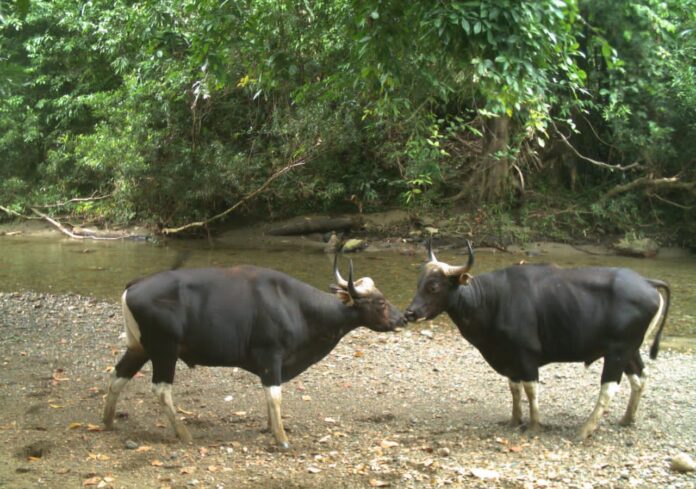Two bull bantengs at a forest reserve in Sabah.-Photo courtesy of DGFC.
KOTA KINABALU: Findings from a state-wide study on the Bornean banteng has concluded that it is absolutely crucial that poaching of the species needs to be eradicated and the population is supplemented with captive-bred individuals to ensure its survival and recovery.
In a scientific paper recently published in the journal Endangered Species Research, scientists and wildlife managers from Danau Girang Field Centre (DGFC), Cardiff University and Sabah Wildlife Department (SWD) collated the first population parameters for the endangered Bornean banteng by developing population models to simulate the effect of different hunting offtake rates.
“Our findings from camera trap surveys suggested that the banteng population in Sabah is geographically divided in four management units based on connectivity: the Northeast (with Paitan and Sugut Forest Reserves), Sipitang Forest Reserve in the West, Central (Deramakot, Tangkulap, Malua, Kuamut and many others Forest Reserves) and Southeast (Kulamba and Tabin Wildlife Reserves) which all require active management to prevent further population decline and local extinction,” said Dr Penny Gardner, who led the state-wide banteng survey project for DGFC and SWD.
“The total population of banteng in Sabah is estimated at a minimum of 320 individuals (figure from 2017).
“A Population Viability modelling exercise (PVA) carried out at an international workshop that we organised on the conservation of the Bornean banteng in 2017, showed us that if only 1% of the population was hunted in Sabah, population growth would cease in the smallest Northeast and Sipitang management units,” said Dr Benoit Goossens, director of DGFC and Professor at Cardiff University.
Goossens said in the Southeast and Central units, growth would cease if 2 and 4% of the bantengs would be hunted, respectively. Extinction was estimated at 21 to 39 years if 5% of the population would be hunted every year, with the central management unit getting extinct last.
“An action plan for Sabah was then drafted and approved by the State Government in June 2019,” said Mohd Soffian Bin Abu Bakar, Assistant Director and Head of Enforcement at Sabah Wildlife Department, and one of the co-authors of the study.
“We are very grateful to Yayasan Sime Darby (YSD) for funding the five-year study and conference, and as a follow-up to the action plan YSD has now continued its support through funding for PROTECT, a boots-on-the-ground enforcement team under the Sabah Forestry Department.
“As another boost to wildlife enforcement, the US Department of State through its Bureau of International Narcotics and Law Enforcement Affairs also provided funding to us in 2019 to set up our own intelligence and forensic units. This funding definitely bolsters our efforts on fighting poaching and illegal trade, and overall will enable us to implement the action plans for the banteng as well as for other wildlife,” Soffian added.
Sabah Wildlife Department director Augustine Tuuga congratulated the authors of this study for clearly demonstrating that banteng hunting can lead to the extinction of the species.
“Our department takes poaching of our totally protected species very seriously and we are currently prosecuting a man for possessing 36.10 kilogrammes of banteng meat in Kota Belud,” said Tuuga.
“Hunting of our Schedule 1 species has to stop, we cannot afford to lose them,” he added.
The banteng study was mainly funded by Yayasan Sime Darby, with additional funding from Houston Zoo, Mohamed bin Zayed Species Conservation Fund, Malaysian Palm Oil Council and Woodland Park Zoo, and supported by the IUCN Asian Wild Cattle Specialist Group.


